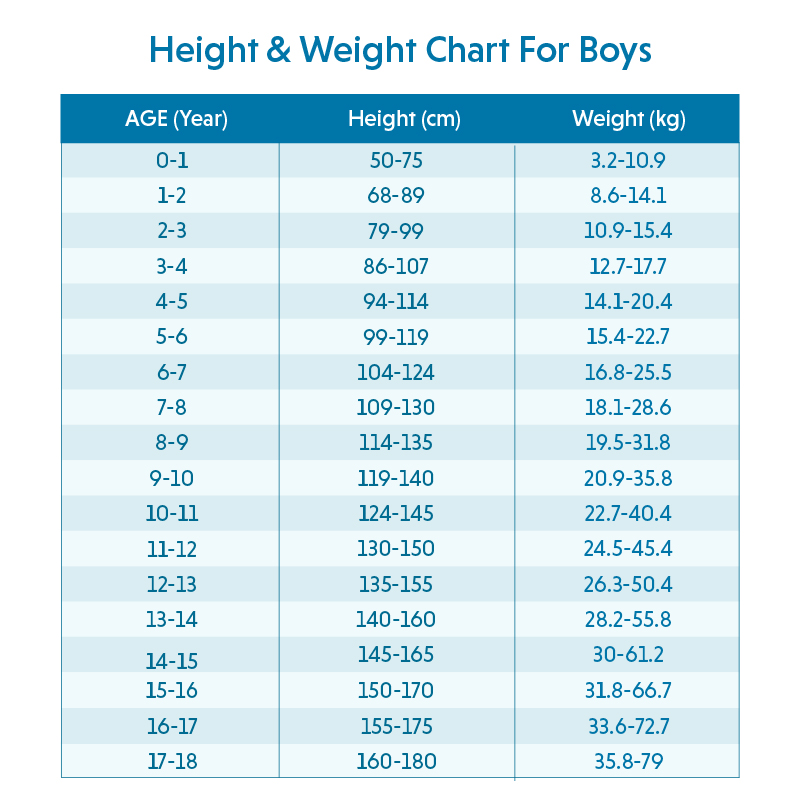Height And Weight Chart For Boys According To Age
Monitoring the growth of boys, including their height and weight, is crucial to ensuring their overall health and development. A height and weight chart for boys is a great tool to help parents and physicians understand growth patterns and effectively track the child’s progress.
Table Of Content

Growth Patterns In Boys
Boys are relatively larger in size than girls at birth and experience rapid growth from infancy to adolescence.
-
Infancy:
At the end of the first year, most boys gain three times their birth weight. Their length also increases by up to 9-10 inches during this time. A reliable baby boy’s height and weight chart can corroborate this.
-
Early childhood (2-6 years):
In this stage the growth is continuous and steady. Boys usually gain up to 2-3 inches in height and 1.8-2.3 kilograms in weight every year.
-
Middle childhood (6-12 years):
Boys usually grow 2-2.5 inches in height yearly during this phase. Physical activity also helps increase muscle mass.
-
Adolescence (12-18 years):
This phase marks a significant growth spurt due to hormonal changes. [1] Boys may gain as much as 4-5 inches in a year as secondary sexual characteristics also develop.
NOTE:
Growth patterns may vary for every child, but these stages form the basis of comparison. Use a reliable boys height weight chart by age and follow it regularly for easy tracking.
Top 5 Factors That Affect The Height And Weight Of Boys
There are several factors affecting changes in your boy’s weight according to height.
Here are some of them listed below:
-
Nutrition:
A balanced diet contains essential nutrients like carbohydrates, proteins, vitamins, healthy fats and minerals in the right proportion. It is vital for optimal growth and development in boys. Adequate nutrition supports bone development and muscle growth, which boosts overall physical health.
-
Genetics:
Factors inherited from parents also determine changes in average height and weight for boys. While genetics form the basis of a child’s growth potential, environmental factors also influence gene expression.
-
Physical Activity:
It is important to remember that regular exercise and physical activity stimulate a child’s growth hormones. They promote healthy bone density and muscle development. An active lifestyle contributes to overall fitness and helps maintain your boy’s weight according to height.
-
Lifestyle:
Many lifestyle choices and factors impact your boy’s weight and height ratio. Some of these are sleep patterns, stress levels, and exposure to environmental toxins. A healthy, stress-free environment with adequate sleep can positively influence growth in height and weight.
-
Hormones:
Hormonal balance, primarily during puberty, is critical in the growth of boys. The testosterone hormone along with several other hormones influences bone growth, muscle development, and the timing of puberty. This, in turn, affects overall height and weight changes in boys.
Why Should You Monitor The Height And Weight Gain In Boys?
Monitoring the average height and weight of boys is essential for several reasons. [2] Here are some of them:
-
Detects Early Growth Anomalies:
Regular monitoring helps identify potential growth disorders or abnormalities at an early stage.
-
Rules Out Nutritional Deficiencies:
It helps identify dietary gaps, if any, for timely action.
-
Prevents Obesity Or Malnutrition:
Using a height and weight chart for boys, parents can identify the early signs of obesity or malnutrition and seek timely medical intervention.
-
Helps Evaluate Overall Health:
Tracking the changes in your boy’s weight according to height can lend valuable insights into his overall health and well-being.
-
Aids Monitoring Of Developmental Milestones:
A height and weight chart for boys is a great tool for tracking progress toward developmental milestones. You can consult your paediatrician quickly if you notice any significant deviations.
Understanding BMI (Body Mass Index)
The interpretation of BMI, or Body Mass Index, is different for children and adolescents compared to adults. BMI acts as a vital tool to assess weight status, and its formula remains the same for adults.
However, its evaluation and interpretation for children and adolescents depends on the peers of the child — those within the same age and gender group, using a percentile metric.
Hence, if a child or adolescent has a BMI at or above the 95th percentile for those of the same age and gender, your medical practitioner may consider him to be obese.
For instance, if a 10-year-old boy is 56 inches tall and weighs 102 pounds with a BMI of 22.9, his BMI percentile places him in the 95th percentile, indicating obesity. This is because the boy’s BMI surpasses 95% of boys of similar age in the reference population.
Height And Weight Charts For Boys:
Here is an easy-to-read height and weight chart for boys in kg. It depicts the average height and weight for boys at different ages:
Age (Years) |
Height Range (in centimeters) |
Weight Range (in kilograms) |
| 0-1 | 50-75 | 3.2-10.9 |
| 1-2 | 68-89 | 8.6-14.1 |
| 2-3 | 79-99 | 10.9-15.4 |
| 3-4 | 86-107 | 12.7-17.7 |
| 4-5 | 94-114 | 14.1-20.4 |
| 5-6 | 99-119 | 15.4-22.7 |
| 6-7 | 104-124 | 16.8-25.5 |
| 7-8 | 109-130 | 18.1-28.6 |
| 8-9 | 114-135 | 19.5-31.8 |
| 9-10 | 119-140 | 20.9-35.8 |
| 10-11 | 124-145 | 22.7-40.4 |
| 11-12 | 130-150 | 24.5-45.4 |
| 12-13 | 135-155 | 26.3-50.4 |
| 13-14 | 140-160 | 28.2-55.8 |
| 14-15 | 145-165 | 30-61.2 |
| 15-16 | 150-170 | 31.8-66.7 |
| 16-17 | 155-175 | 33.6-72.7 |
| 17-18 | 160-180 | 35.8-79 |
To use this height weight chart for boys, locate your child’s age group and follow it to find the corresponding height or weight range. This can help parents track their child’s growth and identify deviations from the average range.
Also Read: Height Weight Chart According To Age For Male & Female
Top 5 Tips For Maintaining Healthy Height & Weight Ratio For Boys
It is crucial to maintain a healthy average height and weight for boys from a young age to build a fit lifestyle. Here are some tips that may help:
-
Balanced Diet:
Ensure your child consumes a balanced diet full of fruits, vegetables, whole grains, lean proteins, and dairy products.
-
Regular Exercise:
Encourage your child to engage in regular physical activity. Sports, swimming and cycling are some excellent options.
-
Limit Screen Time:
Reduce sedentary activities like watching TV or playing video games. Encourage outdoor play instead.
-
Adequate Sleep:
Ensure your child gets enough sleep each night, as it is crucial for growth and overall health.
-
Regular Check-Ups:
Schedule regular check-ups with your paediatrician to monitor his growth and address any concerns promptly.
Monitoring growth through a height and weight chart for boys is essential to ensure the child’s overall health and well-being. By understanding patterns and factors affecting growth, parents can effectively track their children’s developmental milestones. It will help them take timely action to promote optimal growth as per their child’s age.
Frequently Asked Questions Related To Height And Weight Chart For Boys
There is no correct weight and height, but an average range that changes as per the boy’s age. You can refer to a height and weight chart for boys. Alternatively, you can consult a healthcare provider for personalised guidance.
The ideal height and weight for a 4-year-old boy is around 94-114 centimetres. The average weight can be around 14.1-20.4 kilograms.
The ideal height and weight for a 13-year-old boy depend on factors like genetics and overall health. However, boys at this age can have a height between 140 and 160 centimetres and weight between 28.2 and 55.8 kilograms.
The ideal height and weight for a 6-year-old boy vary, but the average height is around 104-124 centimetres, and the average weight is around 16.8-25.5 kilograms.








